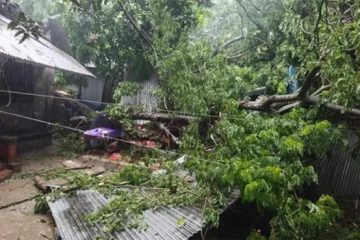 The severely affected people of the areas which bore the brunt of cyclone Aila’s fury in the south-western districts of the country have been suffering from acute shortage of safe drinking water and, as a result, from water-borne diseases in the ongoing dry season. Their water sources were ravaged by Aila, none of which have been restored as yet, reports NewAgebd.
The severely affected people of the areas which bore the brunt of cyclone Aila’s fury in the south-western districts of the country have been suffering from acute shortage of safe drinking water and, as a result, from water-borne diseases in the ongoing dry season. Their water sources were ravaged by Aila, none of which have been restored as yet, reports NewAgebd.
In those districts water crisis generally deepens in the dry season because the ponds dry up, sand filters do not work properly for lack of pond water, rain water harvesters become empty and, above all, salinity increases in the rivers and canals, said local people of the affected areas where, at most places, installation of tube-wells has proved to be useless because the water-table is too deep under the ground.
‘Shortage of safe water — for drinking, bathing and household use — has taken a serious turn this year, and the poor people of the cyclone-stricken areas are forced to use muddy, dirty and saline water from ponds, rivers, canals and ditches,’ said Ratna Baishnab, 27, wife of Prashanta Baishnab of Sutarkhali village in Dacope upazila.
Another woman of the locality, Mariam Begum, 55, wife of late Munsur Sardar, said water-borne diseases like diarrhoea, dysentery, stomach ailments and skin diseases are very common in those areas, and as the people of the affected areas are very poor they have to suffer because of shortage and unavailability of medicines or treatment by local quacks.
Both Ratna and Mariam, like other women of the locality who have taken shelter on both sides of the Kamarkhola-Nalian highway, have to fetch muddy water from Kalibari pond, about two kilometres away from the locality, twice a day. Poor Mariam said that those who have enough money bring water from Dacope upazila headquarters, about 15 kilometres away from the village, by motorised boats.
‘People of some areas can get water from ponds and tube-wells but we can’t. There is a tube-well near our shelter but the water is too salty, so we have to drink and use the water of an adjacent ditch after filtering it through pieces of cloth,’ said 50-year-old Rahila Begum, wife of Janeb Gazi of village Chhoto Jaliakhali.
‘Water-borne diseases have continued till today and we have to go on suffering,’ said Rahila whose family has taken shelter on Kamarkhola-Jaliakhali highroad.
According to the statistics of Khulna’s Department of Public Health Engineering (DPHE), released on 21 July, 2009, Aila damaged 1,161 Pond Sand Filters, 5,231 tube-wells, 1,223 ponds adjacent to PSFs, 1,846 drinking water ponds and 1,36,655 latrines of Khulna, Satkhira and Bagerhat districts.
According to the latest report released on March 7, the DPHE could not restore 4,076 tube-wells and 46 rain water harvesters, and has failed to repair 806 pond sand filters.
The DPHE installed 9 deep tube-wells, 307 shallow tube-wells and 42 plastic tanks, repaired 1,631 tube-wells, cleansed 3,259 tube-wells to free them of germs, distributed 8,961 jerry-cans, 12,03,000 water purifying tablets, 1,382 kilograms of bleaching powder, 980 water purifying filters, 8,68,250 litres of mineral water and 18,78,000 litres of safe water, and set up 7 mobile water treatment plants in the districts on an emergency basis, said the report.
Besides, various NGOs have installed 46 deep tube-wells, 47 shallow tube-wells, 4 pond sand filters and 59 rain water harvesters in Koyra, Dacope and Paikgachha upazilas in Khulna district, said the report.
Sources in Khulna’s DPHE said that rain water harvesters would be useful during the rainy season, and feared that the problems of Aila-stricken areas may not be solved fully until the affected people return to their homesteads.
The Dacope Upazila Health Complex’s medical officer, Dr Santosh Kumar Majumdar, told New Age that the number of patients suffering from water-borne diseases is almost the same in comparison with the previous years.
Khulna DPHE’s executive engineer, Sheikh Abdul Mannan, told New Age that the department has been trying heart and soul to resolve the water crisis of the affected people. He claimed that they have been distributing 4,000 litres of safe water to the affected people everyday.




















